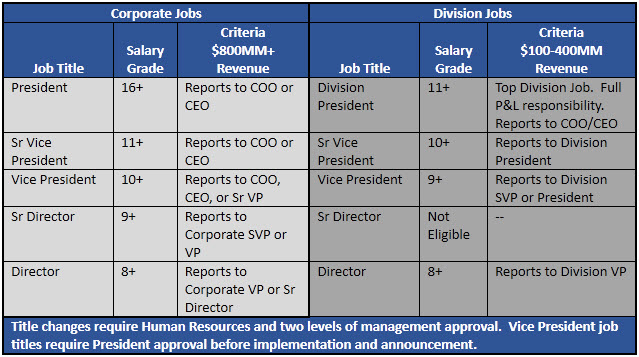The requests to create new and creative job titles are never-ending. Today’s era of title inflation, new technologies, and hot skills places increased demands for new and creative job titling. Executive job titles are even becoming trendy and vague. Hot new skills are rapidly placing increased demand on compensation and new job families. These challenges may even result in new job titles, while others will not. But there is a balance between the creation of new and different job titles and the demand for these jobs and hot skill sets. The management of job titles is an important component in the attainment of market competitiveness, internal equity, and even pay equity throughout an organization.
Today’s era of creative job titling is at an all-time high. Some companies use job title creativity to complement their culture and brand. Some companies are very effective at this, while others create mayhem in their business and organizational hierarchy. The Staffing team frequently cannot recruit for these internal job titles and use secondary job titles for recruiting purposes. Also, these titles may have a different meaning from one company to another. When an employee needs to use a secondary term or title to describe his or her job, the titling standards aren’t working.
For accurate salary information on specific job titles, try ERI’s Salary Assessor for accurate compensation information.
The more creative a job title becomes, the further away it drifts from the common functional areas of business such as sales, marketing, finance and accounting, legal, customer care, human resources, information services, research and development, and operations. When “formal” job titles drift too far and become so unique and trendy, the roles become vague and misunderstood, both internally in the organization and externally in the marketplace. Is this the business culture that a company desires to present to its customers? When a company displays just one set of values throughout the organization for both customers and employees alike, it gains a powerful, competitive advantage in the marketplace.
When job titling is done consistently and well in a company, it promotes fairness and equity throughout the organization. Clarity in roles and job titles also supports pay equity compliance. Without role clarity, it is difficult to attain pay equity in an organization.
It’s important to not over-react to recent trends and buzz words when job titling. Some may be legitimate new titles, while others may not. Proceed cautiously before placing a product name or location in front of a job title. Many companies including salary survey providers proceed cautiously on the creation of new benchmark job titles especially when they may be incorporated into an existing job family over the long term. Hot skills may be more effectively-recognized through higher pay, a sign-on bonus, or even an equity grant.
In the perfect world, job titles will convey the level of authority as well as a descriptor of the primary purpose of the job. The level of the job is typically a noun where the descriptor is an adjective. Acronyms will be avoided. Effective job titling will follow these standards. Ideally, a job title will range from one to five words (one to three is even better).
Ideally, job titles should be well-received by the employees holding the position. For example, Starbucks very effectively uses the term “barista” to describe their customer-facing roles. “Barista” is derived from an Italian word (non-gender specific), for “bartender,” who normally works behind a counter, serving all types of beverages and snacks. The title has been so successful that it is now prevalent in the industry and included in salary surveys.
There’s an opportunity to coin the term “team member” in lieu of “employee” for company-wide communications. This is different from a creative job title. It’s a small but very respectful way to recognize team members, assuming the organization is managed as a team. “Googler” is effectively used by Google, and “Cast Member’ is effectively used by Disney theme parks.

The term “clerk” is certainly outdated. Although the days of “clerk typist” are long over and have been replaced with Office Assistant, Office Associate, Department Assistant, even Clerical Associate, etc., it is eye-opening to see the number of clerk typist jobs currently available on Indeed.com. Higher-level jobs can include the term Specialist as the noun. It is important not to inflate the role with titles such as Administrative Assistant, which is a different and normally higher-level job in the marketplace.
Gender-specific job titles are also outdated and have been replaced with more appropriate gender-neutral titles. It’s also amazing to still see the number of “warehouseman” and “draftsman” job titles on Indeed.com, where a simple change to warehouse worker, warehouse associate, warehouser, or drafter are simple, more up-to-date titles.
So why would a company need or desire to change its receptionist job title to Director, First Impressions? The spiral of title inflation begins with one title change such as this one. Internal equity breaks down — especially as an organization grows. An organization’s hierarchy needs to be established based on internal equity and market competitiveness. Will the job be paid like a Director or just titled as a Director? What happens when the employee wants to be recognized as a Director in pay and benefits? What happens when other employees request a similar inflated title for their jobs as well? Although this example is extreme, a Manager who is given the HRIS title of Director may have expectations in pay and benefits (even equity compensation) immediately or down the road.
If a new standard in job titling is approved in an organization (such as Senior Director), a ripple effect can also quickly take place throughout an entire business. The term Director no longer has the same meaning when a Senior Director title has been approved in a company. Before a new, significant management titling structure is used, it is important to carefully assess the ramifications throughout a business. It can also influence external market competitiveness when expectations are created due to liberal or inflated job titling practices.
Career ladders can be of great value in the management of job families and the title hierarchy within a business. Defined career ladders are important programs in the attraction, development, and retention of critical employees. Ideally, career opportunities for R&D staff should provide comparable growth opportunities whether an individual contributor or management role is pursued. A career ladder will support in providing comparable growth opportunities for key individual contributors who elect to stay on an individual contributor career path. For example, If STEM individual contributors are all pursuing their MBAs, it may be a sign that the professional career ladder isn’t working effectively. As appropriate, recognizing and rewarding these talented employees for their technical expertise should include growth opportunities up to a Vice President level. A critical, high-performing Engineer, nationally or internationally recognized in his or her field of expertise, who is an important company resource with proven success in new product design and development, may be an excellent candidate for an Engineering Fellow — see career ladder example below:

In some organizations, management job titles can become very political and place inappropriate pressure on advancement. These issues become more prevalent with acquisitions and smaller divisions when prior job titles are retained. Once the standard lowers within an organization for a management job title, a ripple effect can easily run through an organization. A job title policy, approved by top management, can create top management ownership to the job titling structure and help eliminate title negotiation, inflation, and inconsistencies for senior management job titles. Appropriate approval is needed along with a required reporting relationship, salary grade, and a minimum business revenue size.
Example – Job Title Policy

Although there are a lot of variations to these types of management job title matrices, they can provide tremendous guidance to an organization and support in attaining market competitiveness and internal equity.
Effective job design today also includes broader roles with flexibility for job enrichment opportunities. Job titles should follow this theme as well. Narrowly designed jobs should be implemented with caution. Millennials (as well as other generations) don’t want to be defined by their job title — they want workplace flexibility, career development, and a sense of purpose. Don’t we all want that? The ability to provide new, interesting assignments and work locations on a temporary, project or team basis can present new and interesting opportunities for employee development and engagement. This can even influence a reduction in employee turnover.
Jobs titles, whether unique or not, should have a specific purpose, value, and meaning. Take proactive steps to avoid title inflation. The next time a unique, creative job title is being considered, ask yourself if the decision really influences internal equity and employee engagement, makes the business a better place to work, and supports the company culture and brand.
ERI’s Occupational Assessor breaks down job analysis by reflecting an individual’s training, experience, and limitations to generate lists of jobs with requirements falling within these restrictions. Therefore, employees’ job titles clearly communicate the level and responsibility of their positions.
ERI Economic Research Institute compiles the most robust salary, cost-of-living, and executive compensation survey data available, with current market data for more than 1,000 industry sectors.
ERI’s Assessor Series® – Solutions for every compensation decision




